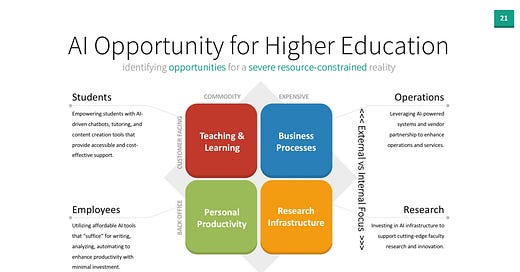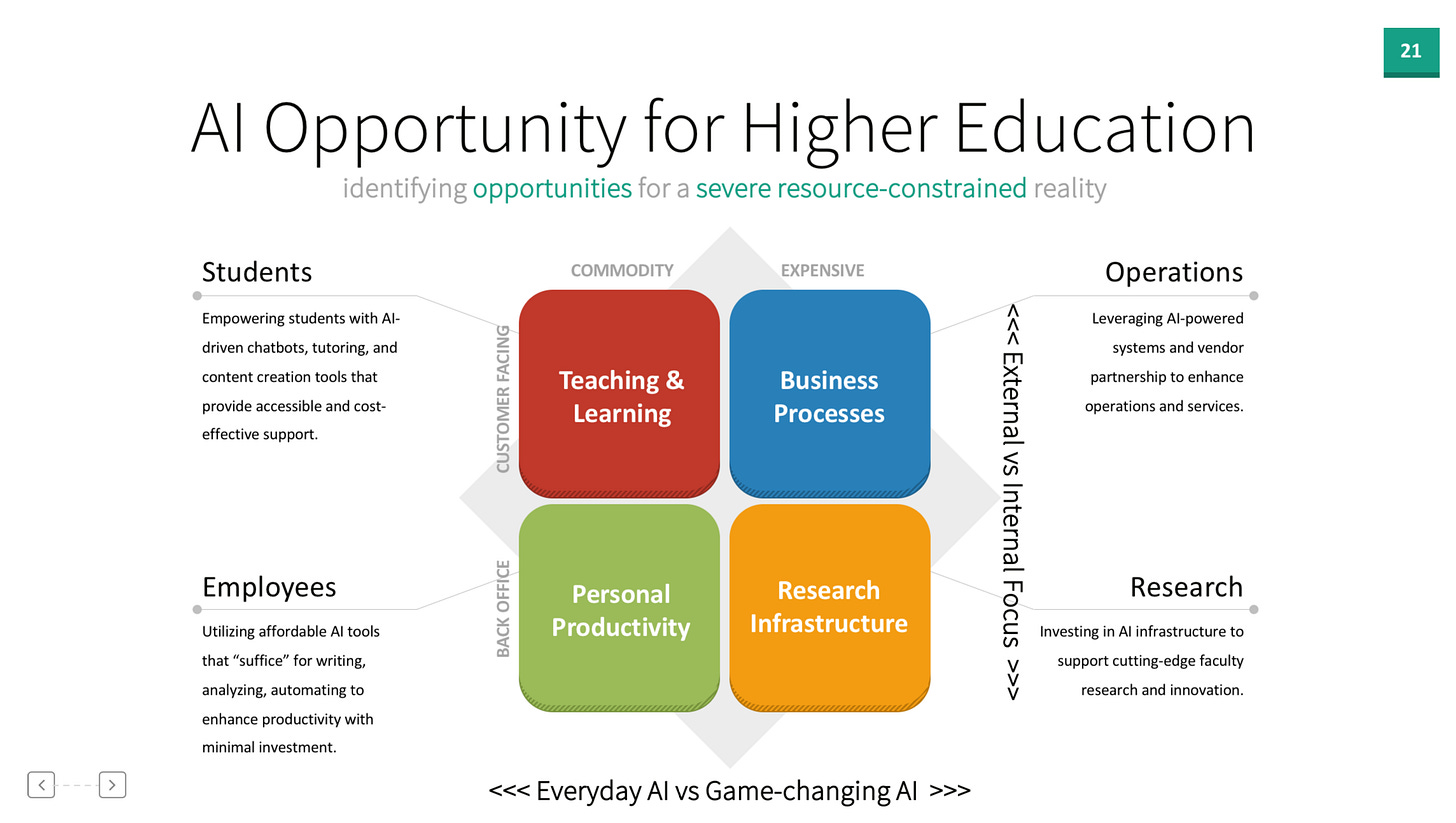AI in Higher Ed: What Matters and What’s Just Hype
A framework for making AI investments that actually move the needle.
I started my IT career in 1997, just a few years after the Internet transformed everything—creating unprecedented opportunities for universities and launching careers for people like me. Back then, I was the go-to problem solver, the one called when legacy systems—monolithic and difficult to integrate—needed quick Internet-enabled solutions. I had great mentors—Steve Williams, Tom Putnam, and Pierce Cantrell—who taught me that success in IT isn’t just about technology; it’s about vision, long hours and hard work, and “sweating the details” together.
Now, nearly 30 years later, it’s my turn to mentor and support hundreds of IT professionals through the next major transformation: Generative AI. There’s no doubt that GenAI will be even more socially, economically, and structurally disruptive for higher education than the Internet itself—but that doesn’t mean every institution should rush in and try everything for fear of being behind. In today’s Dispatch, I break down how universities should approach GenAI strategically—where it makes sense to invest, and where being prudent is the smarter move.
Why it matters:
AI is rapidly reshaping higher education, but not all AI investments are created equal. Institutions must distinguish between everyday AI, which provides incremental efficiency gains, and game-changing AI, which requires significant investment and has the potential to fundamentally transform operations. Additionally, AI initiatives can be categorized by their operational focus—whether they are internal (faculty, staff, research) or external (student services and institutional operations).
Breaking it down:
Everyday AI: The Low-Cost, High-Accessibility Play
Everyday AI is already making its way into universities through widely available tools that enhance efficiency, improve workflows, create and analyze content, and support students and staff—all at relatively low cost.
For students: AI-powered chatbots, tutoring assistants, and generative tools (e.g., AI-driven note summarization, research assistants, and content creation tools) help students navigate coursework without requiring major institutional investments. Many of these tools are now freely available through third-party platforms.
For faculty and staff: AI-enhanced writing assistants, meeting transcription services, and automated email sorting increase productivity with minimal investment. Faculty members are already using AI to generate syllabi, craft recommendation letters, and refine research proposals.
For operations: Many software vendors now integrate AI-powered automation for scheduling, workflow management, and basic analytics. Universities don’t need to develop AI solutions from scratch—existing enterprise tools (like Microsoft, Google, and Apple) are embedding AI natively into their platforms.
The bottom line: Everyday AI is low-cost, easy to adopt, and widely accessible. Institutions should embrace these solutions to boost efficiency, but they won’t fundamentally transform higher education.
Game-Changing AI: The Big Bets
Unlike everyday AI, game-changing AI is a high-risk, high-reward investment. It requires significant financial resources but has the potential to unlock transformative capabilities.
For faculty research: For faculty research: AI-driven high-performance computing (HPC), GPU clusters, and AI-powered research labs provide faculty with cutting-edge tools for large-scale data analysis, AI-driven simulations, and automation of research tasks. However, these investments are expensive and often require strategic partnerships with industry leaders and funding agencies.
For institutional systems: AI-powered LMS (Learning Management Systems), SIS (Student Information Systems), and CRM (Customer Relationship Management systems) can personalize learning experiences, enhance student engagement, and optimize administrative decision-making. However, success depends on how well vendors integrate AI into these platforms, as most institutions lack the in-house resources and expertise to develop AI-driven enterprise applications.
For strategic decision-making: AI-powered predictive analytics can help universities forecast enrollment trends, identify at-risk students, and optimize resource allocation. Some institutions are exploring AI-enhanced governance tools to guide financial planning, staffing, and long-term strategy, but the accuracy and ethical implications of such AI-driven decision-making are still being debated.
The bottom line: Game-changing AI has transformative potential but requires careful investment, strategic alignment, and strong vendor partnerships to avoid wasted resources.
What’s Next?
A balanced AI strategy is key. Institutions should maximize the benefits of free or inexpensive everyday AI that “suffices” while making selective, strategic investments in game-changing AI where there is a clear competitive advantage.
Prioritize efficiency first: Everyday AI solutions can be adopted quickly and at scale to improve faculty, student, and administrative productivity without breaking the budget.
Invest where AI is a differentiator: Institutions should focus game-changing AI investments in areas where they provide a clear strategic advantage—such as research infrastructure, AI-driven decision-making, and cutting-edge enterprise systems.
Leverage vendor solutions where possible: Universities should push existing enterprise software vendors to incorporate AI innovation rather than trying to build custom AI solutions from scratch. This approach minimizes cost while still gaining access to powerful AI capabilities at scale.
Avoid writing code: leverage low-code solutions: Where universities want to build their own AI-powered tools, they should avoid custom code development from scratch. Instead, they should adopt low-code and no-code platforms like Microsoft’s Copilot Studio, which allow institutions to deploy AI-powered workflows while avoiding the long-term costs of extensive software development.
The bottom line:
AI can enhance higher ed, but not all AI investments are equal. Universities should avoid chasing the hype and instead adopt a measured, strategic approach—leveraging low-cost everyday AI for efficiency while investing in game-changing AI only where it truly moves the needle.




